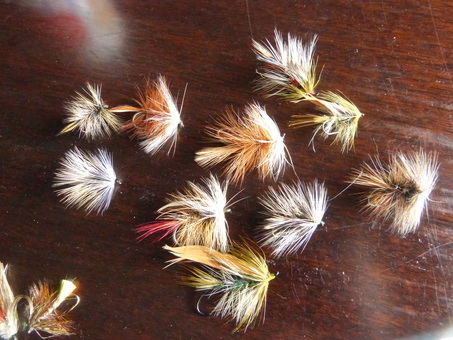Big Trout
There are five different types of big trout
1. Ferrox
2. Large solitary cannibal trout that eat their own kind
3. Naturally bred trout of a uniformly large size that live in fertile environments with lots of food
4. Artificially bred fish. I.e. big farmed rainbows
5. Trout that grow big because of a sudden increase in food in their environment. I.e. when a fish cage is placed in a loch.
1-Ferrox trout are the large predatory trout that live in deep lochs feeding on the shoals of Arctic char , which in Shetland live only in the loch of Girlsta. Ferrox trout are top of the food chain, exist in small numbers and are rarely seen yet alone caught -especially on the fly.
Catching a true ferrox on the fly remains possibly one of the greatest challenges in Shetland Angling though over the years a few have been caught from Girlsta. In Scotland ferrox trout are mostly caught by deep trolling dead baits or large lures along the contours of the loch.
For further reading see the excellent book - Ferrox Trout by Ron Greer.
2- The Large Solitary Cannibal
When a wild trout gets to a certain size the only high protein food source available to them in sufficient size and quantity especially from the less fertile lochs is to eat their own species. These cannibals are top of the food chain; few in number and because of the size of food they eat do not need to eat very often and consequently are rarely caught. WH Lawrie says in his book 'Big Trout' that almost without exception these big trout are mainly nocturnal feeders-though this is only partly true because they still show from time to time in the day.
Catching these large cannibal’s on the fly by design is an area of fly fishing that has great scope for tactical development though the difficulty of trying to catch these fish by design on the fly should not be underestimated
Some of the difficulties are
- the kind of waters these cannibals live in are usually full of small trout and so generally not fished seriously by those in search of big fish
- They exist in small numbers being top of the food chain and do not need to feed often because of the size of the food they eat.
- To cast fly’s the size of small trout is not easy on the 6/7 wt. rods most commonly used by loch anglers and investing in i.e. 8-9 wt. rods needed takes the pursuit into another dimension of commitment and seriousness that is likely to be a picture of lots of effort for very little reward- however the challenge is there
- It's very difficult to resist the joy of catching lots of smaller trout that are more numerous and put on large trout imitating fly’s where the odds are stacked heavily against the angler
- 3-Naturally bred trout of a uniformly large size that live in fertile environments with lots of food
Shetland is blessed with some very productive lochs with lots of natural feeding that can grow superb trout and as well as lochs that support large numbers of good conditioned trout. Size of fish is relative to the population density and availability of food , lochs with good natural spawning can support a large number of smaller fish and lochs with poor spawning contain fewer and bigger fish.
Some lochs have large populations of high protein food such as shrimp and stickle back. Lochs with large populations of freshwater snails (which is a high protein year round fodder requiring little effort on the part of the trout to eat) can support a big population of trout of a high average size.
4- Artificially bred fish. I.e. big farmed rainbows.
There are no stockings of large artificially bred Rainbows in Shetland however it is possible that large trout brood stock from fish farming activities may have found there way into the wild which explains some of the huge fish that have been caught from certain waters overs the years. Fish from this kind of water are not eligible for the Shetland record or allowed to be weighed in at competitions because they are not wild fish.
5- Trout that grow big because of a sudden increase in food in their environment.
When a fish farming cage is placed in a freshwater environment there is a dramatic increase in the amount of nutrients going into that water.
When the site for the cage is well chosen i.e. with a very large catchment area of water flowing through to keep the water relatively fresh the ecological environment becomes artificially enriched but is still able to function, with a massive increase in the availability of food for trout to eat. These waters make exciting angling environments because they can grow very big trout but the fish caught in them are not considered for the Shetland record or allowed to be weighed in in fishing competitions because of the artificiality of the environment.
Do we need big flies to catch big trout?
The answer is both yes and no dependant on conditions and the water being fished. If the water being fished is known to contain big trout and the fish are not obviously feeding on something very specific then a big fly can be a good tool to lure a big trout especially if it's windy. Likewise when it's calm a big fly is more likely to scare a fish than attract it.
However if there is something specific on the menu i.e. a hatch , or on a loch where the fish are known to be feeding on particular food item then it can be more productive to match the hatch and small imitative flies come into their own. Also a great many big trout are caught every year on size 10 and 12 loch flies.
However for those that like the idea of 'big flies for big fish' the following big flies have proven track record of catching big trout in Shetland. See also David Pottinger's fly page on this site, the Black Country Man in in March 2015 cast of the month, and Mike Forbes fritz shrimp in September 2015 cast of the month. The patterns will be added to on a regular basis.
There are five different types of big trout
1. Ferrox
2. Large solitary cannibal trout that eat their own kind
3. Naturally bred trout of a uniformly large size that live in fertile environments with lots of food
4. Artificially bred fish. I.e. big farmed rainbows
5. Trout that grow big because of a sudden increase in food in their environment. I.e. when a fish cage is placed in a loch.
1-Ferrox trout are the large predatory trout that live in deep lochs feeding on the shoals of Arctic char , which in Shetland live only in the loch of Girlsta. Ferrox trout are top of the food chain, exist in small numbers and are rarely seen yet alone caught -especially on the fly.
Catching a true ferrox on the fly remains possibly one of the greatest challenges in Shetland Angling though over the years a few have been caught from Girlsta. In Scotland ferrox trout are mostly caught by deep trolling dead baits or large lures along the contours of the loch.
For further reading see the excellent book - Ferrox Trout by Ron Greer.
2- The Large Solitary Cannibal
When a wild trout gets to a certain size the only high protein food source available to them in sufficient size and quantity especially from the less fertile lochs is to eat their own species. These cannibals are top of the food chain; few in number and because of the size of food they eat do not need to eat very often and consequently are rarely caught. WH Lawrie says in his book 'Big Trout' that almost without exception these big trout are mainly nocturnal feeders-though this is only partly true because they still show from time to time in the day.
Catching these large cannibal’s on the fly by design is an area of fly fishing that has great scope for tactical development though the difficulty of trying to catch these fish by design on the fly should not be underestimated
Some of the difficulties are
- the kind of waters these cannibals live in are usually full of small trout and so generally not fished seriously by those in search of big fish
- They exist in small numbers being top of the food chain and do not need to feed often because of the size of the food they eat.
- To cast fly’s the size of small trout is not easy on the 6/7 wt. rods most commonly used by loch anglers and investing in i.e. 8-9 wt. rods needed takes the pursuit into another dimension of commitment and seriousness that is likely to be a picture of lots of effort for very little reward- however the challenge is there
- It's very difficult to resist the joy of catching lots of smaller trout that are more numerous and put on large trout imitating fly’s where the odds are stacked heavily against the angler
- 3-Naturally bred trout of a uniformly large size that live in fertile environments with lots of food
Shetland is blessed with some very productive lochs with lots of natural feeding that can grow superb trout and as well as lochs that support large numbers of good conditioned trout. Size of fish is relative to the population density and availability of food , lochs with good natural spawning can support a large number of smaller fish and lochs with poor spawning contain fewer and bigger fish.
Some lochs have large populations of high protein food such as shrimp and stickle back. Lochs with large populations of freshwater snails (which is a high protein year round fodder requiring little effort on the part of the trout to eat) can support a big population of trout of a high average size.
4- Artificially bred fish. I.e. big farmed rainbows.
There are no stockings of large artificially bred Rainbows in Shetland however it is possible that large trout brood stock from fish farming activities may have found there way into the wild which explains some of the huge fish that have been caught from certain waters overs the years. Fish from this kind of water are not eligible for the Shetland record or allowed to be weighed in at competitions because they are not wild fish.
5- Trout that grow big because of a sudden increase in food in their environment.
When a fish farming cage is placed in a freshwater environment there is a dramatic increase in the amount of nutrients going into that water.
When the site for the cage is well chosen i.e. with a very large catchment area of water flowing through to keep the water relatively fresh the ecological environment becomes artificially enriched but is still able to function, with a massive increase in the availability of food for trout to eat. These waters make exciting angling environments because they can grow very big trout but the fish caught in them are not considered for the Shetland record or allowed to be weighed in in fishing competitions because of the artificiality of the environment.
Do we need big flies to catch big trout?
The answer is both yes and no dependant on conditions and the water being fished. If the water being fished is known to contain big trout and the fish are not obviously feeding on something very specific then a big fly can be a good tool to lure a big trout especially if it's windy. Likewise when it's calm a big fly is more likely to scare a fish than attract it.
However if there is something specific on the menu i.e. a hatch , or on a loch where the fish are known to be feeding on particular food item then it can be more productive to match the hatch and small imitative flies come into their own. Also a great many big trout are caught every year on size 10 and 12 loch flies.
However for those that like the idea of 'big flies for big fish' the following big flies have proven track record of catching big trout in Shetland. See also David Pottinger's fly page on this site, the Black Country Man in in March 2015 cast of the month, and Mike Forbes fritz shrimp in September 2015 cast of the month. The patterns will be added to on a regular basis.
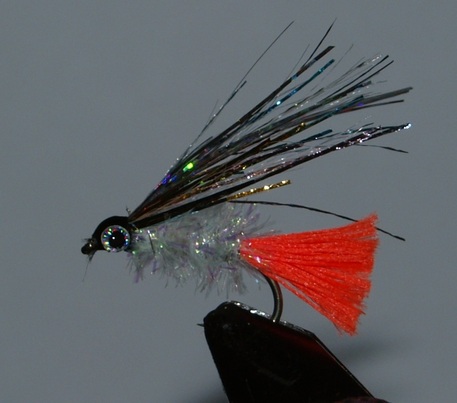
BROUSTER SPARKLER - Mike Forbes
HOOK Kamasan B175 size 10-6
SILK Black
TAIL Glowbrite No 5
BODY White Sparkle Fritz ribbed with silver wire
WING Rainbow Mobile topped with silver Flashabou
HEAD Black silk with Stick on eyes set with UV Resin
HOOK Kamasan B175 size 10-6
SILK Black
TAIL Glowbrite No 5
BODY White Sparkle Fritz ribbed with silver wire
WING Rainbow Mobile topped with silver Flashabou
HEAD Black silk with Stick on eyes set with UV Resin
|
Dapping Flies- Tied by Colin Wiseman
Big trout are suckers for a large dry fly and these large dapping flies are tied on size 8 and long shank hooks. Gink them up and have no more than two on a cast of strong line and allow them to trip across the waves. Some anglers still use traditional dapping rods in Shetland. |
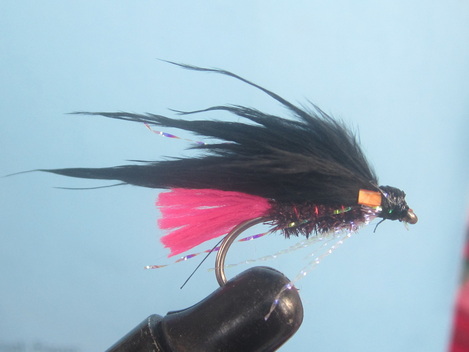
Magenta Killer- tied by Paul Bloomer
Hook B 175 8 - 6
Tail -GB 1
Body - Peacock herl dyed magenta
Rib-Red Wire
Wing- Black Marabou
Cheeks - Slips of fluorescent sunburst goose biot
Throat- UV crystal flash
Brian watt was responsible for popularising the combination of black and magenta for for fishing in low light conditions with his excellent black and magenta muddler. This fly is basically a variation on that theme minus the black deer hair muddler head. In Hugh Falkus's famous book on sea trout he advises the use of very opaque materials when fishing at night because the fish predominately see by silhouette. Peacock hero is one such opaque material and black is the first choice colour being the darkest tone. Conversely all white flies especially with a tail of GB 11 also work well in the dark i.e. Cats Whisker type patterns.
Hook B 175 8 - 6
Tail -GB 1
Body - Peacock herl dyed magenta
Rib-Red Wire
Wing- Black Marabou
Cheeks - Slips of fluorescent sunburst goose biot
Throat- UV crystal flash
Brian watt was responsible for popularising the combination of black and magenta for for fishing in low light conditions with his excellent black and magenta muddler. This fly is basically a variation on that theme minus the black deer hair muddler head. In Hugh Falkus's famous book on sea trout he advises the use of very opaque materials when fishing at night because the fish predominately see by silhouette. Peacock hero is one such opaque material and black is the first choice colour being the darkest tone. Conversely all white flies especially with a tail of GB 11 also work well in the dark i.e. Cats Whisker type patterns.
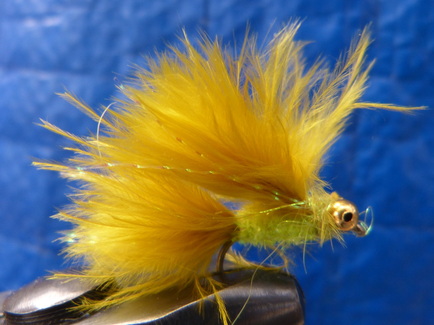
Yellow Cat- Gilbert Williams
Hook B 175 8-10
Tail and Wing- Golden Olive Marabou with a few strands of crystal flash
Body- Yellow Light Brite
Chain bead eyes
Chain eyed Cats in various colour combinations are superb catchers of big trout and this yellow cat is no exception. There are not many all yellow flies in the loch trout box and on its day this fly can be excellent. This fly is a good choice for coloured water but can work equally well in clear water with many big fish falling to its charms.
Hook B 175 8-10
Tail and Wing- Golden Olive Marabou with a few strands of crystal flash
Body- Yellow Light Brite
Chain bead eyes
Chain eyed Cats in various colour combinations are superb catchers of big trout and this yellow cat is no exception. There are not many all yellow flies in the loch trout box and on its day this fly can be excellent. This fly is a good choice for coloured water but can work equally well in clear water with many big fish falling to its charms.
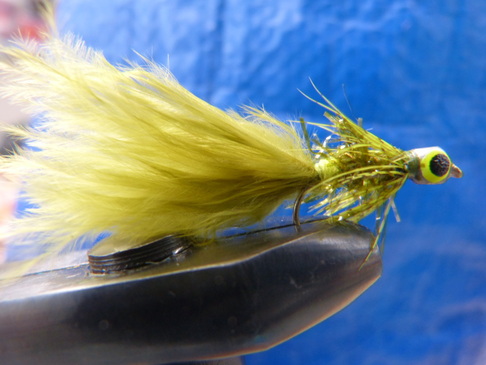
GT- Paul Grevet
This fly found its way to Shetland after a request on the face book group 'Fishy' for advice on flies to catch stickleback feeding trout. Paul kindly sent one through the post to try and within a week it had caught multiple trout between 2-4 pounds from a variety of very different lochs. The combination of heavy lead head with fluorescent eyes and extra long mobile marabou tail makes this fly really come alive in the water . A black version also works very well in Shetland.
Its Creator says
'The GT was developed as a competition fly that was responsible for me winning four Bob Church Championships .
The fly has enough flash to attract without scaring and plenty of movement can be imparted to the fly. It is deadly where fish are feeding on sticklebacks as well as other fry'
Paul is offering them for sale in various colour combinations at £1.49 each plus postage contact [email protected]
This fly found its way to Shetland after a request on the face book group 'Fishy' for advice on flies to catch stickleback feeding trout. Paul kindly sent one through the post to try and within a week it had caught multiple trout between 2-4 pounds from a variety of very different lochs. The combination of heavy lead head with fluorescent eyes and extra long mobile marabou tail makes this fly really come alive in the water . A black version also works very well in Shetland.
Its Creator says
'The GT was developed as a competition fly that was responsible for me winning four Bob Church Championships .
The fly has enough flash to attract without scaring and plenty of movement can be imparted to the fly. It is deadly where fish are feeding on sticklebacks as well as other fry'
Paul is offering them for sale in various colour combinations at £1.49 each plus postage contact [email protected]
